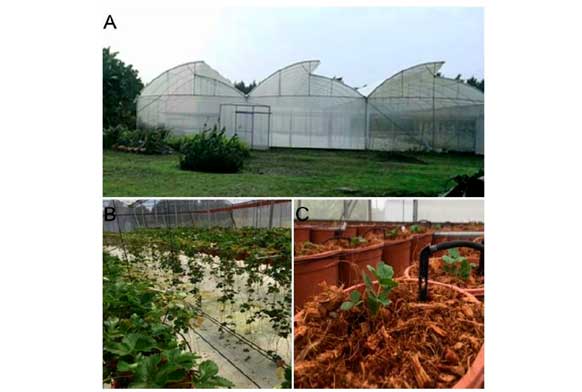Effect of vernalization on strawberry stolon production
DOI:
https://doi.org/10.29312/remexca.v14i1.3187Keywords:
Fragaria × ananassa Duchesne ex Rozier, cold hours, vegetative propagationAbstract
In strawberry cultivation, reproduction by stolons is the most used due to its low cost, the quantity and homogeneity of the daughter plants. Although it has the ability to produce stolons naturally, they can be exposed to vernalization periods to increase the yield and quality of planting material. This research aimed to determine the production of stolons and daughter plants of the varieties Albión, Festival and Oso Grande exposed to four vernalization temperatures under greenhouse conditions, in Heredia, Costa Rica, between September 2018 and February 2019. The following were quantified: the number and length of stolons; as well as the number of daughter plants per stolon, of 50 plants per variety, exposed to 0, 250, 500 and 750 cold hours at 6 °C. The three variables showed statistically significant differences with respect to the control. Plants of all varieties produced more stolons when vernalized. Festival obtained the highest number of plants per stolon with 250 cold hours (5) and Oso Grande with 500 cold hours had the longest stolon length, 143 cm. It was concluded that there is an effect of vernalization on the production of stolons and daughter plants depending on the variety.
Downloads
References
Andrés-Jiménez, J.; Caruana, J.; Liang, J.; Samad, S.; Monfort, A.; Liu, Z.; Hytonen, T. and Koskela, E. A. 2021. Woodland strawberry axillary bud fate is dictated by a crosstalk of environmental and endogenous factors. Plant Physiol. 187(3):1221-1234. https://doi.org/ 10.1093/plphys/kiab421.
da Costa, R. C.; Calvete, E. O.; Mendonça, H. F. C. e DeCosta, L. A. 2014. Fenologia e acúmulo de folhas em mudas vernalizadas e não vernalizadas em morangueiro de dias neutros. Acta Sci. Agron. 36(1):57-62. https://doi.org/10.4025/actasciagron.v36i1.17285.
de Oliveira, R. P.; Brahm, R. U. and Scivittaro, W. B. 2017. Produção de mudas de morangueiro em casa-de-vegetação utilizando recipientes suspensos. Hortic. Bras. 25(1):107-109.
Diel, M. I.; Pinheiro, M. V. M.; Cocco, C.; Thiesen, L.A; Altíssimo, B. S.; Fontana, D. C.; Caron, B. O; Testa, V. and Schmidt, D. 2017. Artificial vernalization in strawberry plants: Phyllochron, production and quality. Austr. J. Crop Sci. 11(10):1315-1319. https://doi.org/10.21475/ajcs.17.11.10.pne603.
FAO. 2002. Food and Agriculture Organization of the United Nations. El cultivo protegido en clima Mediterráneo. http://www.fao.org/3/s8630s/s8630s00.htm#Contents.
FAOSTAT. 2022. Food and Agriculture Organization of the United Nations, Statistics Division. Production/yield quantities of strawberries in world. https://www.fao.org/faostat/ en/#data/QCL.
Husaini, A. M. and Wen, X. Y. 2016. Challenges of climate change to strawberry cultivation: uncertainty and beyond. In: Amjad, M.; Husaini and D. Neri. Ed. Strawberry growth, development and diseases. 1ra. Ed. 323 p.
IICA. 2017. Instituto Interamericano de Cooperación para la Agricultura. Manual de buenas prácticas agrícolas y de producción para el cultivo de la fresa. IICA, San José, Costa Rica. 5-60 p.
INEC. 2015. Instituto Nacional de Estadística y Censos. VI Censo Nacional Agropecuario: cultivos agrícolas, forestales y ornamentales. 285 p.
Jiménez, J. P. y Alvarado, E. B. 2014. Evaluación de dos medios de cultivo en la micropropagación de fresa (Fragaria x ananassa Duch). Rev. jóvenes en la ciencia. 1(1):92-95.
MAG. 2021. Ministerio de Agricultura y Ganadería de Costa Rica. Censo actividad fresera en Costa Rica. (Presentación Powerpoint). San José, Costa Rica.
Matamoros-Solorzáno, G. 1996. La fresa, prácticas del cultivo. Programa de comunicación agrícola, Universidad de Costa Rica. 1-29 pp.
Rivera-Berrú, D. M. 1993. Efecto de la vernalización en la fructificación de fresa (Fragaria x ananassa Duch.) cv Chandler. Escuela Agrícola Panamericana, Zamorano. 1-38 pp.
Rodríguez-Bautista, G.; Calderón-Zavala, G.; Jaen-Contreras, D. y Curiel-Rodríguez, A. 2012. Capacidad de propagación y calidad de planta de variedades mexicanas y extranjeras de fresa. Rev. Chapingo Ser. Hortic. 18(1):113-123.
Shaw, D. V. and Larsson, K. D. 2006. Strawberry plant named ‘Albion’. (United States plant patent USPP16228P3) The Regents of the University of California, Oakland, CA (US). https://patents.google.com/patent/USPP16228P3/en.
Strand, L. 2008. Integrated pest management for strawberries. University of California. 2a Ed. Division Agriculture and Natural Resourses. https://books.google.sc/books?id=2ertGX mmwDwCandlpg=PA5andpg=PR3#v=onepageandqandf=false.
Zumbado, C.; Paniagua, G. y Castro, A. A. 1994. Cultivo y comercialización de la fresa en Costa Rica. In: Atlas agropecuario de Costa Rica. San José, Costa Rica. 225-235 pp.

Published
How to Cite
Issue
Section
License
Copyright (c) 2023 Revista Mexicana de Ciencias Agrícolas

This work is licensed under a Creative Commons Attribution-NonCommercial 4.0 International License.
The authors who publish in Revista Mexicana de Ciencias Agrícolas accept the following conditions:
In accordance with copyright laws, Revista Mexicana de Ciencias Agrícolas recognizes and respects the authors’ moral right and ownership of property rights which will be transferred to the journal for dissemination in open access. Invariably, all the authors have to sign a letter of transfer of property rights and of originality of the article to Instituto Nacional de Investigaciones Forestales, Agrícolas y Pecuarias (INIFAP) [National Institute of Forestry, Agricultural and Livestock Research]. The author(s) must pay a fee for the reception of articles before proceeding to editorial review.
All the texts published by Revista Mexicana de Ciencias Agrícolas —with no exception— are distributed under a Creative Commons License Attribution-NonCommercial 4.0 International (CC BY-NC 4.0), which allows third parties to use the publication as long as the work’s authorship and its first publication in this journal are mentioned.
The author(s) can enter into independent and additional contractual agreements for the nonexclusive distribution of the version of the article published in Revista Mexicana de Ciencias Agrícolas (for example include it into an institutional repository or publish it in a book) as long as it is clearly and explicitly indicated that the work was published for the first time in Revista Mexicana de Ciencias Agrícolas.
For all the above, the authors shall send the Letter-transfer of Property Rights for the first publication duly filled in and signed by the author(s). This form must be sent as a PDF file to: revista_atm@yahoo.com.mx; cienciasagricola@inifap.gob.mx; remexca2017@gmail.
This work is licensed under a Creative Commons Attribution-Noncommercial 4.0 International license.


